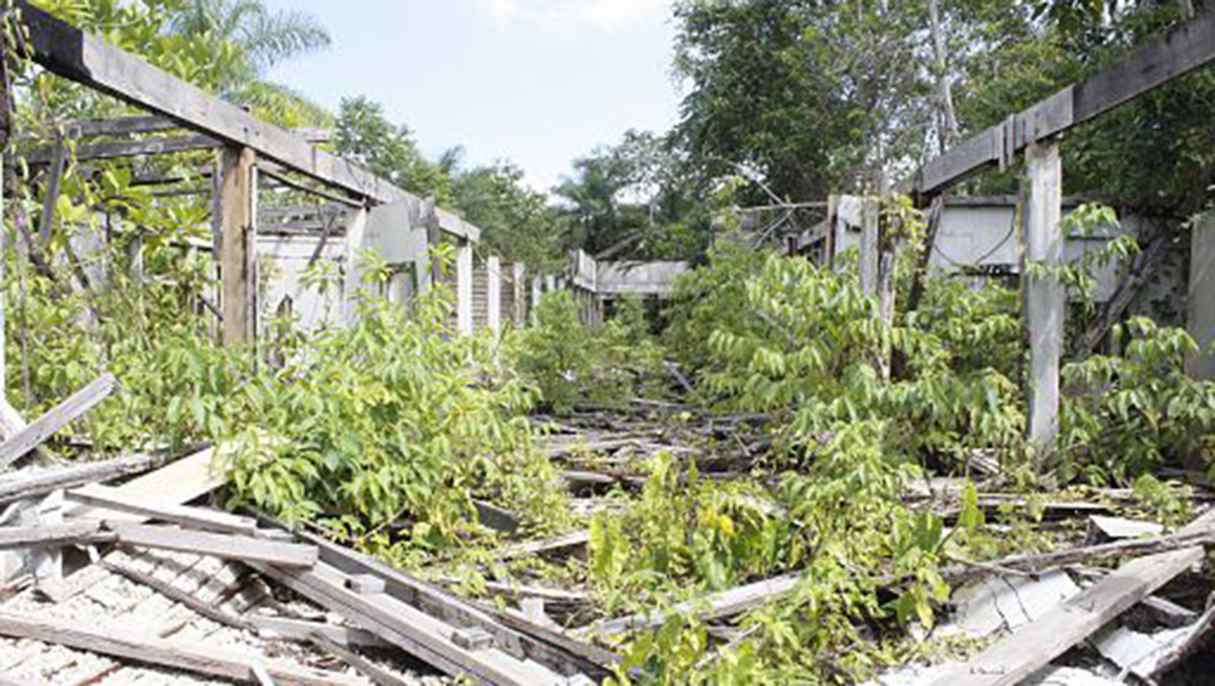Did you know that Henry Ford built a town?
That's not even a wanky metaphor for the impact the Ford Motor Company had on Dearborn, Michigan. Nope, Henry Ford built an entire goddamn town. From scratch. In the middle of the Amazon rainforest. And like any good megalomaniac would, he named it after himself.
The town was Fordlandia and in addition to sounding like the setting for some choice Brave New World fan-fiction, it was supposed to be Henry Ford's chance to export his vision of utopian Americana to the rest of the world.
It, uh... Didn't go as well as he expected it to.

What was Fordlandia?
Why would Henry Ford need to build a town? I mean how weird would it be if we got Jobs-ville, or Zuckerberg-burg, or the United States of Donald Tru- wait...
Fordlandia was a company town, built to accommodate the workers for a planned rubber plantation owned by the Ford Motor Company. See, in the 1920s Ford had really hit its stride and was producing everything it needed to make cars in-house. Everything, that is, except latex, which was monopolised by England and the Netherlands with plantations in Burma and Sri Lanka.
Rather than give in to price gouging, Ford invoked the time-honoured American tradition of telling England to go to hell, and he decided to just make the rubber himself.
So, he did what any reasonable businessman would do and acquired a piece of land roughly the size of a small U.S. state in the middle of the Amazon, set fire to it, then started work on his plantation.

"Dearborn in the Jungle"
According to Greg Grandin who literally wrote the book on Fordlandia (Which you can buy if you want a deeper perspective on Fordlandia's history than this thinly veiled excuse for me to look at pictures of ruin porn and get paid for it), Fordlandia was a chance for Ford to export his idea of a utopian, midwest factory town to another corner of the world.
The town had everything it needed to support itself. According to 'The Henry Ford' (a not-for-profit organisation consisting of the Henry Ford Museum of American Innovation, Greenfield Village, Ford Rouge Factory Tour and the Benson Ford Research Center) in their history of Ford rubber plantations in Brazil, Fordlandia had multiple schools, churches, a fire department, stores, a library and radio stations.
Not to mention a hospital that was apparently designed by Stanley Kubrick.

Fordlandia produced its own power, had its own water purification plant and even had social amenities like a golf course and a community dance hall. Because as we all learned from year seven P.E. classes, nothing brings people together like compulsory square dancing.
All of that being said, it seems like it was a pretty good deal, right? Your job feeds you, shelters you and entertains you. At most jobs you need to run the damn company before you even get somewhere to park your car. What could possibly go wrong?

Aside from awkward dance parties?
What happened to Fordlandia?
The short answer? This:

There were a few reasons why Fordlandia died the way it did. For starters, the rubber plantation was a colossal failure. Which, hey, it's not like that was the sole purpose of the town or anything.
Part of the problem was that the plantation was supervised by Ford employees who, because they'd spent their careers overseeing factories, weren't exactly up to speed on the finer points of horticulture.
Okay, fine, but what's to know? You plant trees, the trees grow, you tap them for their sweet, sweet rubbery juices and before you know it you're sitting on a throne of Ford brand tyres.
The thing is though, one of the reasons why the rubber plantations on the other side of the world were so successful was because in those environments rubber trees have no native predators.
Ford's mission of cultural imperialism, bringing a "Dearborn style of life" to the Amazon, wasn't going as well as he'd hoped.
Unfortunately for Ford this isn't the case in South America, and it wasn't long before the trees at Fordlandia were completely decimated by fungus and insects, just like your mattress was in your first share-house.
On top of that, Ford's mission of cultural imperialism, bringing a "Dearborn style of life" to the Amazon, wasn't going as well as he'd hoped.
Workers at Fordlandia were expected to punch in for a nine-to-five workday. While this is fine in Michigan, doing so in the tropics meant working during the hottest parts of the day, instead of before and after sunset like all the workers were used to.
On top of that, the alien, Midwestern-style food they were supplied with caused widespread stomach problems. Think of the worst case of burger cramps you've ever had, now imagine how bad it would be if you'd never built up all those years of burger tolerance.
On top of THAT Ford also enforced prohibition, throwing tobacco onto the banned list as well. But as the history of prohibition has taught us, booze will find a way. It's like Jurassic Park but with vomiting and liver disease.

For the people of Fordlandia, who wanted to do a little recreational poisoning, that meant travelling upstream to the "Island of Innocence", because apparently "Island of totally no booze and brothels whatsoever" would have seemed suspicious.
So, take a brutal workday, throw in nasty stomach upsets and an inability to drink away your sorrows in the comfort of your own home, and what do you get?
Riots. You get riots. And a massive employee turnover rate.
Fordlandia abandoned
Fordlandia was soon replaced by another plantation called Belterra. The new site was more successful, in that it actually produced rubber, but even then it was only a fraction of the volume originally expected.
By the end of World War II the Ford Motor Company had no use for its Brazillian plantation and it was sold back to the Brazillian governemnt for $250,000.
So Fordlandia sat, abandoned, for nearly 80 years. People have started to move back to the town and it has had some life brought back to it. But as far as being a shining beacon of prosperity for both Ford and the Amazon, not so much.
Maybe Zuckerberg-burg will be a safer bet. Who knows?




.jpg)



